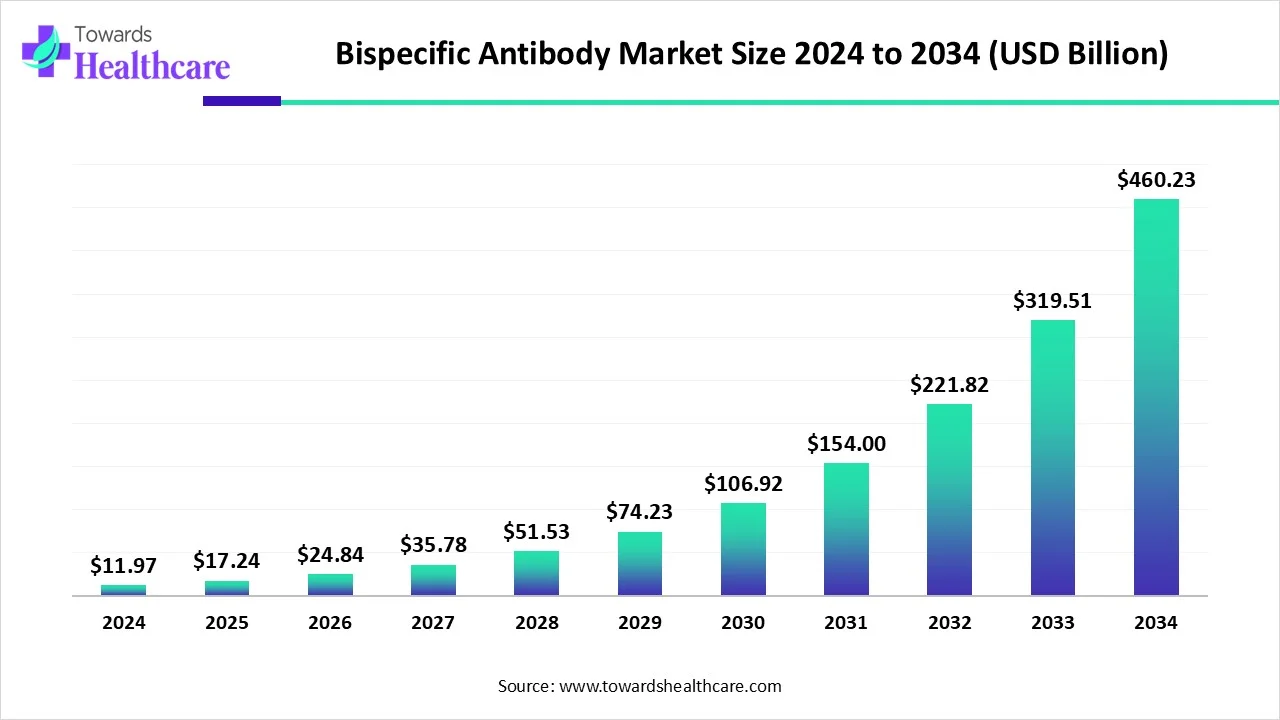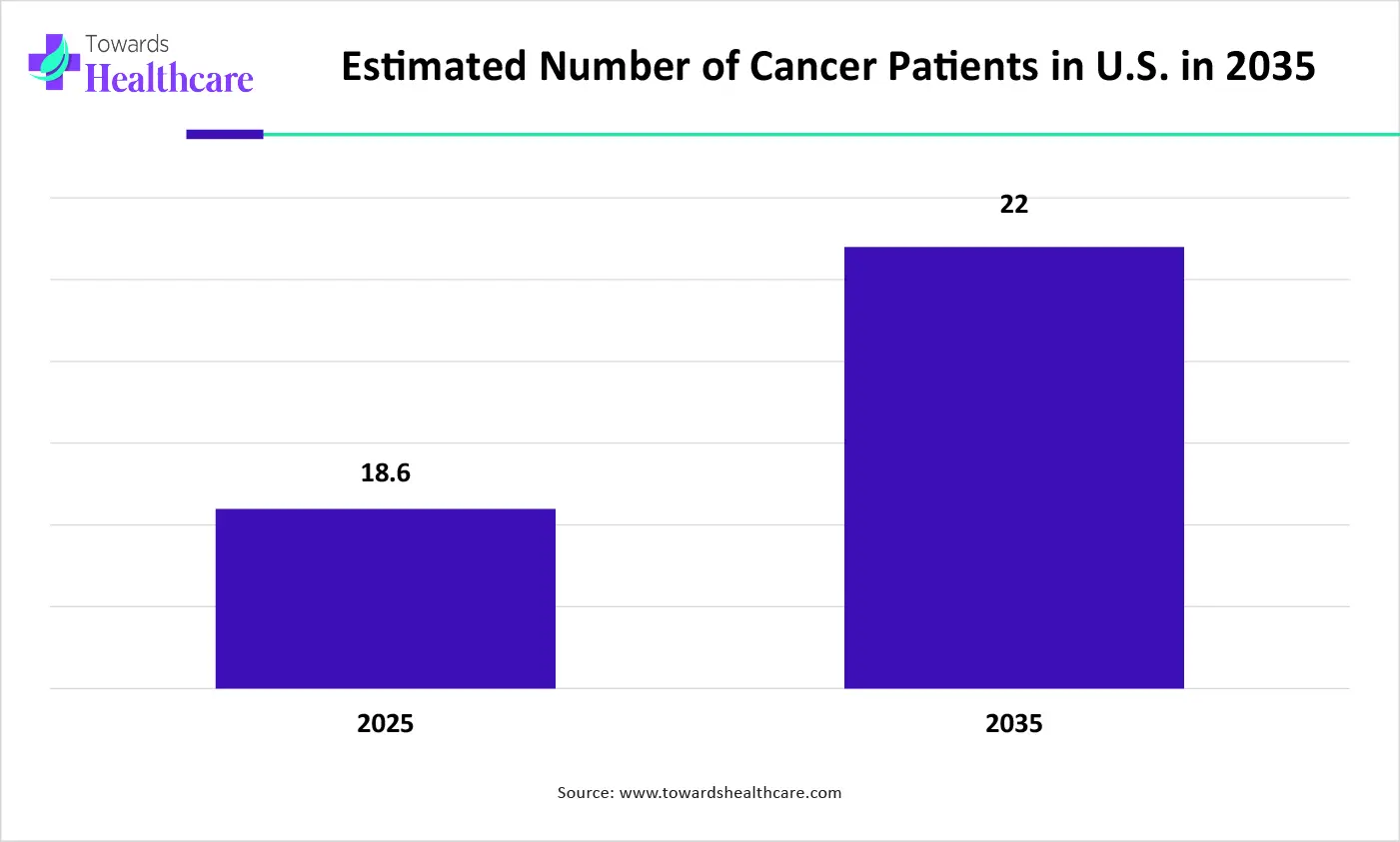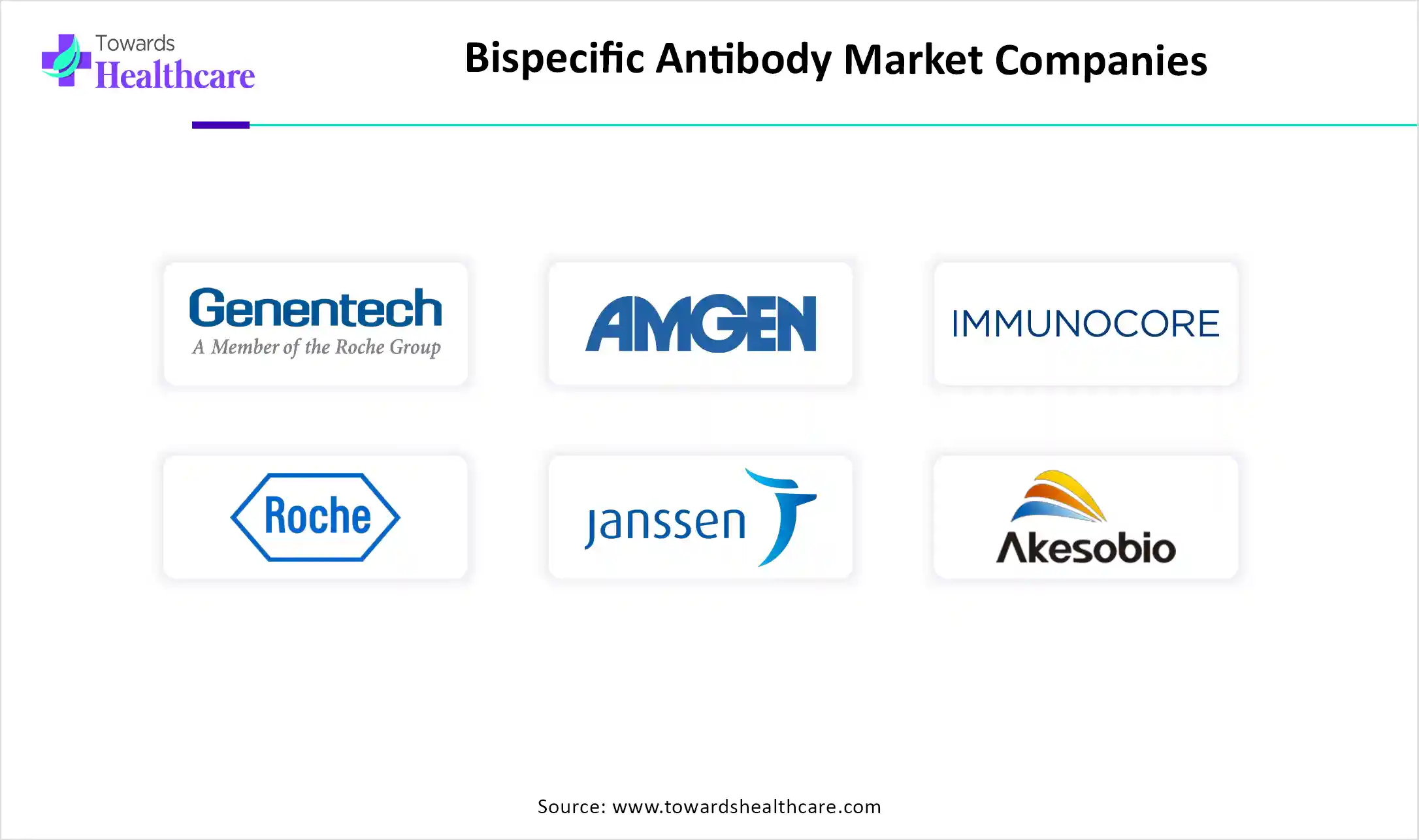October 2025

The global bispecific antibody market size is calculated at USD 11.97 in 2024, grew to USD 17.24 billion in 2025, and is projected to reach around USD 460.23 billion by 2034. The market is expanding at a CAGR of 44.04% between 2025 and 2034.

The bispecific antibody market is focusing on the development of new treatment approaches due to its benefit of dual targeting. At the same time, partnerships and agreements are also contributing to the same. Additionally, the growing use of AI in the development of these antibodies is also rising as it is enhancing their safety, specificity, and targeting action.
Moreover, the rising cases of cancer are playing an important role in driving these developments. Simultaneously, the well-developed healthcare, advancing industries, and chronic diseases also increase the demand for bispecific antibodies.
| Metric | Details |
| Market Size in 2025 | USD 17.24 Billion |
| Projected Market Size in 2034 | USD 460.23 Billion |
| CAGR (2025 - 2034) | 44.04% |
| Leading Region | North America |
| Market Segmentation | By Indication, By Region |
| Top Key Players | Genentech, Amgen, Immunocore, Roche, Janssen, Akeso, Inc., Taisho Pharmaceutical |
Bispecific antibodies play an important role in the next generation of antibody therapy. With the help of bispecific antibodies, two different antigens could be targeted at the same time, for example, it can bind to tumor cell receptors and redirect cytotoxic immune cells. The rapidly growing structural diversity is driving the novel bispecific antibody scaffolds, enhancing the functional variety in the bispecific antibody field. Moreover, the full-length IgG-like asymmetric antibody and the single-chain variable fragment (scFv)-based (no Fc fragment) antibody are its two common formats. Thus, with the help of these bispecific antibodies, various therapeutic potentials are being enhanced.
The use of AI in bispecific antibodies provides various advantages in their analysis as well as in the development process. At the same time, the use of AI and machine learning in predicting the bispecific targets for successful drug development is increasing. Moreover, these predictions are also being used in the development of various target combinations. Hence, to improve the interpretation of these predictions, the machine learning models are being merged with Large Language Models (LLMs). Thus, with the help of AI specificity, targets and safety can be enhanced.
Increasing Occurrences of Cancer
There is a rise in the incidence of chronic diseases such as cancer. This, in turn, increases the demand for new treatment options. Hence, the use of bispecific antibodies as treatment increases. These antibodies help in attacking the tumor cells by redirecting the immune cells to the targeted sites. This increases the body’s defence mechanism to fight against cancer. This, in turn, reduces the side effects and enhances the patient's adherence to the treatment. Thus, the growing occurrence of cancer drives the bispecific antibody market growth.

The graph represents the estimated number of cancer patients in the U.S. in year of 2025. It indicates that there will be a rise in cases of cancer. Hence, it increases the demand for new bispecific antibody treatment options for its effective management. Thus, this in turn will ultimately promote the market growth.
Intricate Production
The development of bispecific antibodies is complex as it requires advanced engineering platforms, which may create certain challenges during their manufacturing. This, in turn, increases the need for sophisticated instruments for their development. At the same time, the risk of quality, consistency, as well as scalability are also associated with it. Thus, this complex production process can act as a restraint on the market growth.
Why are Growing Developments an Opportunity in the Bispecific Antibody Market?
Due to the rising prevalence of various diseases, the demand for the use of bispecific antibodies is rising. At the same time, their use in the development of personalized medication or therapies depending on the patient's characteristics is being enhanced. Furthermore, to improve the effectiveness of the treatment, the bispecific antibodies are also being used in combination therapies. This strategy is providing a synergistic effect in the treatment of various diseases. Thus, all these factors promote the market growth.
For instance,
By indication type, the cancer segment led the market in 2024. The growing incidence of cancer increased the demand for the use of bispecific antibodies. It helped in redirecting the immune cells towards the tumor cells, enhancing the body’s defence mechanism, which in turn, contributed to the market growth.
By indication type, the inflammatory and autoimmune disorders segment is expected to grow significantly at a notable CAGR during the predicted time. The use of bispecific antibodies in inflammatory and autoimmune disorders is increasing due to their target-specific action. At the same time, it also enhances the body’s immune responses, which increases patient outcomes.
North America dominated the bispecific antibody market in 2024. North America consisted of a well-developed healthcare sector with the presence of advanced technology as well as skilled personnel. Thus, this enhanced the development of bispecific antibody, contributing to the market growth.
The U.S. Bispecific Antibody Market Trends
The healthcare sector in the U.S. is advanced as it uses advanced technologies in the development process. This further helps in improving the scalability as well as the consistency of the specific antibodies developed.
The Canada Bispecific Antibody Market Trends
The demand for the use of bispecific antibodies in Canada is increasing. Thus, with the help of skilled personnel and advanced technologies, their development and production rates are being enhanced with improved quality of the antibodies.
Europe is expected to host the fastest-growing bispecific antibody market during the forecast period. Europe is experiencing a rise in the incidence of chronic diseases such as cancer and autoimmune disorders. This increases the demand for bispecific antibodies, which in turn enhances the market growth.
The Germany Bispecific Antibody Market Trends
The growing prevalence of cancer in Germany is increasing the use of bispecific antibodies. These show targeted action minimizing the side effects, which improves the patient outcomes as well as adherence, contributing to their growing demands.
The UK Bispecific Antibody Market Trends
The industries in the UK are focusing on the development of new treatment approaches with the use of bispecific antibodies, due to the growing disease. At the same time, this increases the number of collaborations between the industries to enhance the innovative approaches.
Asia Pacific is expected to grow significantly in the bispecific antibody market during the forecast period. The industries in Asia Pacific are adopting various new technologies, as well as growing research and development are increasing the use of bispecific antibodies in the treatment of rising diseases. This promotes the market growth.
The China Bispecific Antibody Market Trends
Due to a large population, the diseases in China are growing. At the same time, the adoption of new technologies in industries is facilitating new development in bispecific antibody treatment approaches. Thus, their use in personalized medications is also growing.
The India Bispecific Antibody Market Trends
The Indian industries are focusing on the development of new treatment options with the use of bispecific antibodies to treat rising diseases. At the same time, support is also provided by the government.
Latin America is expected to grow at a notable CAGR in the bispecific antibody market in the foreseeable future. The increasing prevalence of cancer and the rising healthcare expenditure foster the market. The growing research and development activities and increasing R&D investments lead to the development of bispecific antibodies. The burgeoning medical tourism due to affordable treatment costs encourages foreign patients to visit Latin America.
Brazil Market Trends
The clinical trial infrastructure is expanding at a rapid rate in Brazil. As of October 2025, a total of 17 clinical trials are registered from Brazil related to bispecific antibodies on the clinicaltrials.gov website. This further enhances the significance of bispecific antibodies in clinical applications.
The Middle East & Africa are expected to grow at a considerable CAGR in the upcoming period. Favorable government support and the rising adoption of advanced technologies augment the market. People are becoming aware of personalized medicines due to rapidly changing demographics and the growing geriatric population. The market growth is also driven by improved healthcare infrastructure and the rising prevalence of cancer and autoimmune disorders.
UAE Market Trends
The Ministry of Health and Prevention regulates the approval of novel drugs and medical devices in the UAE. The “Flagship Personalized Precision Medicine Programme” by the Abu Dhabi government promotes the development of personalized medicines, including bispecific antibodies. Apart from these initiatives, the Emirati Genome Programme (EGP) and the National Genome Strategy, initiatives provide a framework for the genomics sector.

The latest research on bispecific antibodies focuses on identifying expanded applications other than cancer and developing antibodies with reduced side effects.
Key Players: Evitria AG, Akeso Biopharma Co., Ltd., and Amgen.
Clinical trials are conducted to study the safety and efficacy of bispecific antibodies, which are then subsequently approved by regulatory agencies.
Key Players: Xuanzhu Biopharmaceutical Co., Ltd., Shenzhen Majory Biotechnology Co., Ltd., and Beijing Mabworks Biotech Co., Ltd.
Patient support & services refer to comprehensive education on risk and monitoring, and guiding patients about the dose and delivery systems.
By Indication
By Region
October 2025
October 2025
October 2025
October 2025